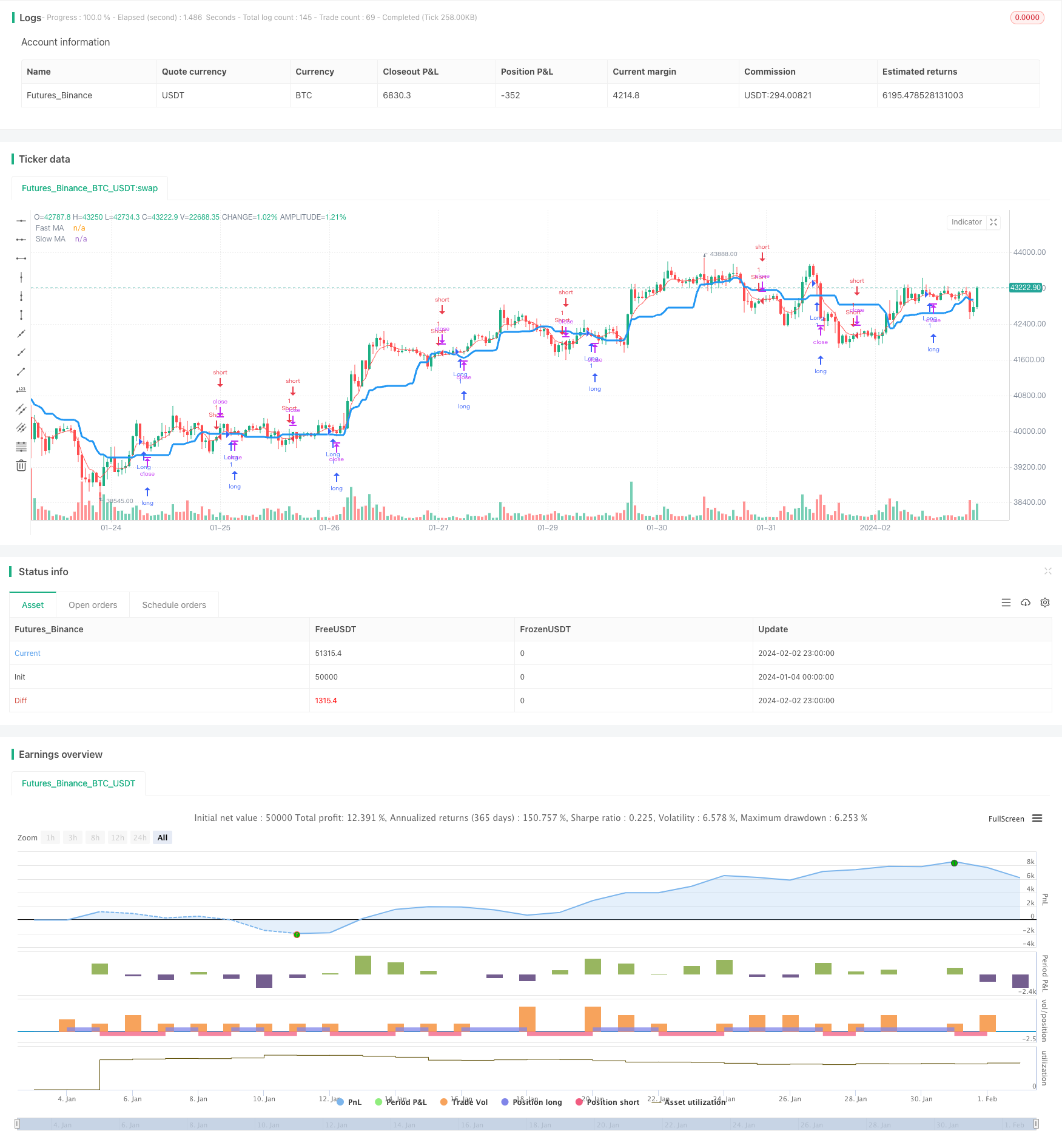動向平均の二重トレンド追跡戦略
作者: リン・ハーンチャオチャン,日付: 2024-02-04 15:57:12タグ:

概要
ダブル・ムービング・アベア トレンド・トラッキング戦略は,トレンド方向を決定するために,テンポと速度を緩める移動平均を組み合わせ,エントリー信号としてキャンドルスタイクの体色を使用する.この戦略にはトレンドフォローと平均逆転の両方の特徴がある.
原則
この戦略は,全体的なトレンドを定義するために20期間のスロームービング・平均値を使用する. 上向きクロスオーバーは上昇傾向を示唆し,下向きクロスオーバーは下向き傾向を示唆する. 5期間の速いMAはエントリーフィルターとして機能する. 価格が速いMAを突破するときにのみ取引が起動する. さらに,最近のNキャンドルボディカラーがチェックされる. 上向きのトレンドでボディカラーが赤くなるときにロング信号が起動する. 下向きのトレンドでボディカラーが緑色になるとショート信号が起動する. これは偽のブレイクを避けるのに役立ちます.
この戦略は,トレンド,短期MA,キャンドルスタイクボディの3つの次元を用いて価格アクションを調査し,シグナル信頼性を向上させる.
利点
-
トレンドフォローと平均逆転を組み合わせ,市場環境に適応できる.
-
複数の要素による 前の信号のレビューは 誤った信号を回避することで 勝利率を向上させます
-
MA長さ,キャンドル色等をチェックして最適化できます
-
わかりやすく,簡潔で,初心者向けです.
リスク
-
レンジ市場におけるウィップソーは損失/引き下げにつながる.損失制限またはMAパラメータの最適化を検討する.
-
横向する際に潜在的な鞭打ちは損失を引き起こす可能性があります.チェックされたろうそくの数を調整したり,平均逆転を無効にしようとします.
-
パラメータとパフォーマンスを検証するために 広範なバックテストが必要でした
強化
-
他のMA型を調査する.EMA,KAMAなど.
-
固定量または%の株式に基づいて,例えば,ポジションのサイズのルールを追加します.
-
ストップ・ロスのメカニズムを組み込む.価格がMAの低値を下回る場合はロングを終了することを検討する.
-
安定性を確認するために,異なる機器でテストする.
結論
ダブルMA戦略は,より短い時間枠で平均逆転アルファを抽出しながらトレンドトレードから利益を得ます.最適化によってパフォーマンスと利益の可能性はさらに向上することができます. シンプルにもかかわらず,初心者はトレンドと平均逆転を組み合わせるための重要な概念を把握することができます. ツールとパラメータ全体で包括的な検証が必要です.
/*backtest
start: 2024-01-04 00:00:00
end: 2024-02-03 00:00:00
period: 1h
basePeriod: 15m
exchanges: [{"eid":"Futures_Binance","currency":"BTC_USDT"}]
*/
//@version=2
strategy(title = "Noro's Trend MAs 1.5", shorttitle = "Trend MAs 1.5", overlay=true, default_qty_type = strategy.percent_of_equity, default_qty_value=100.0, pyramiding=0)
//Settings
needlong = input(true, "long")
needshort = input(true, "short")
type = input(7, defval = 7, minval = 1, maxval = 7, title = "Type of Slow MA")
src = input(close, defval = close, title = "Source of Slow MA")
usefastsma = input(true, "Use fast MA Filter")
fastlen = input(5, defval = 5, minval = 1, maxval = 50, title = "fast MA Period")
len = input(20, defval = 20, minval = 2, maxval = 200, title = "slow MA Period")
bars = input(2, defval = 2, minval = 0, maxval = 3, title = "Bars Q")
fastsma = ema(src, fastlen)
//DEMA
dema = 2 * ema(src, len) - ema(ema(close, len), len)
//TEMA
xPrice = close
xEMA1 = ema(src, len)
xEMA2 = ema(xEMA1, len)
xEMA3 = ema(xEMA2, len)
tema = 3 * xEMA1 - 3 * xEMA2 + xEMA3
//KAMA
xvnoise = abs(src - src[1])
nfastend = 0.20
nslowend = 0.05
nsignal = abs(src - src[len])
nnoise = sum(xvnoise, len)
nefratio = iff(nnoise != 0, nsignal / nnoise, 0)
nsmooth = pow(nefratio * (nfastend - nslowend) + nslowend, 2)
kama = nz(kama[1]) + nsmooth * (src - nz(kama[1]))
//PriceChannel
lasthigh = highest(src, len)
lastlow = lowest(src, len)
center = (lasthigh + lastlow) / 2
//Trend
ma = type == 1 ? sma(src, len) : type == 2 ? ema(src, len) : type == 3 ? vwma(src, len) : type == 4 ? dema : type == 5 ? tema : type == 6 ? kama : type == 7 ? center : 0
trend = low > ma ? 1 : high < ma ? -1 : trend[1]
//Bars
bar = close > open ? 1 : close < open ? -1 : 0
redbars = bars == 0 ? 1 : bars == 1 and bar == -1 ? 1 : bars == 2 and bar == -1 and bar[1] == -1 ? 1 : bars == 3 and bar == -1 and bar[1] == -1 and bar[2] == -1 ? 1 : 0
greenbars = bars == 0 ? 1 : bars == 1 and bar == 1 ? 1 : bars == 2 and bar == 1 and bar[1] == 1 ? 1 : bars == 3 and bar == 1 and bar[1] == 1 and bar[2] == 1 ? 1 : 0
//Signals
up = trend == 1 and (low < fastsma or usefastsma == false) and redbars == 1 ? 1 : 0
dn = trend == -1 and (high > fastsma or usefastsma == false) and greenbars == 1 ? 1 : 0
//Lines
colorfastsma = usefastsma == true ? red : na
plot(fastsma, color = colorfastsma, title = "Fast MA")
plot(ma, color = blue, linewidth = 3, transp = 0, title = "Slow MA")
//Trading
longCondition = up == 1
if (longCondition)
strategy.entry("Long", strategy.long, needlong == false ? 0 : na)
shortCondition = dn == 1
if (shortCondition)
strategy.entry("Short", strategy.short, needshort == false ? 0 : na)
- 動的移動平均のクロスオーバーコンボ戦略
- ウィリー・ウォンカ 脱出戦略
- 指数関数移動平均値と相対強度指数の組み合わせ トレンド 戦略に従う
- 逆転傾向のキャッチとダイナミックストップロスのコンボ戦略
- ゴールデンパラボラのブレイクアウト戦略
- SARモメント逆転追跡戦略
- ダイナミックなRSI取引戦略
- 複数の移動平均値間のクロスオーバー戦略
- 2つの移動平均のブレイクアウト戦略
- 移動平均のクロスオーバー戦略
- 2次インパクト ツーパーインディケーター タイミング戦略
- レンコと相対活力指数の傾向 戦略をフォローする
- スウィングトレンド 移動平均戦略
- ボリンジャー・バンド,移動平均値,MACDの組み合わせた取引戦略
- モメント価格上昇 暗号通貨戦略
- 多因子モデルに基づくモメンタム・トレーディング戦略
- アダプティブ・ボリンジャー・バンドのトレンド・トラッキング戦略
- ストップ・ロストとテイク・プロフィートの改善されたRSIブレークアウト戦略
- RSIとボリンジャー・バンドに基づいた定量的な取引戦略
- SMAとローリングトレンドラインに基づいた定量的な取引戦略